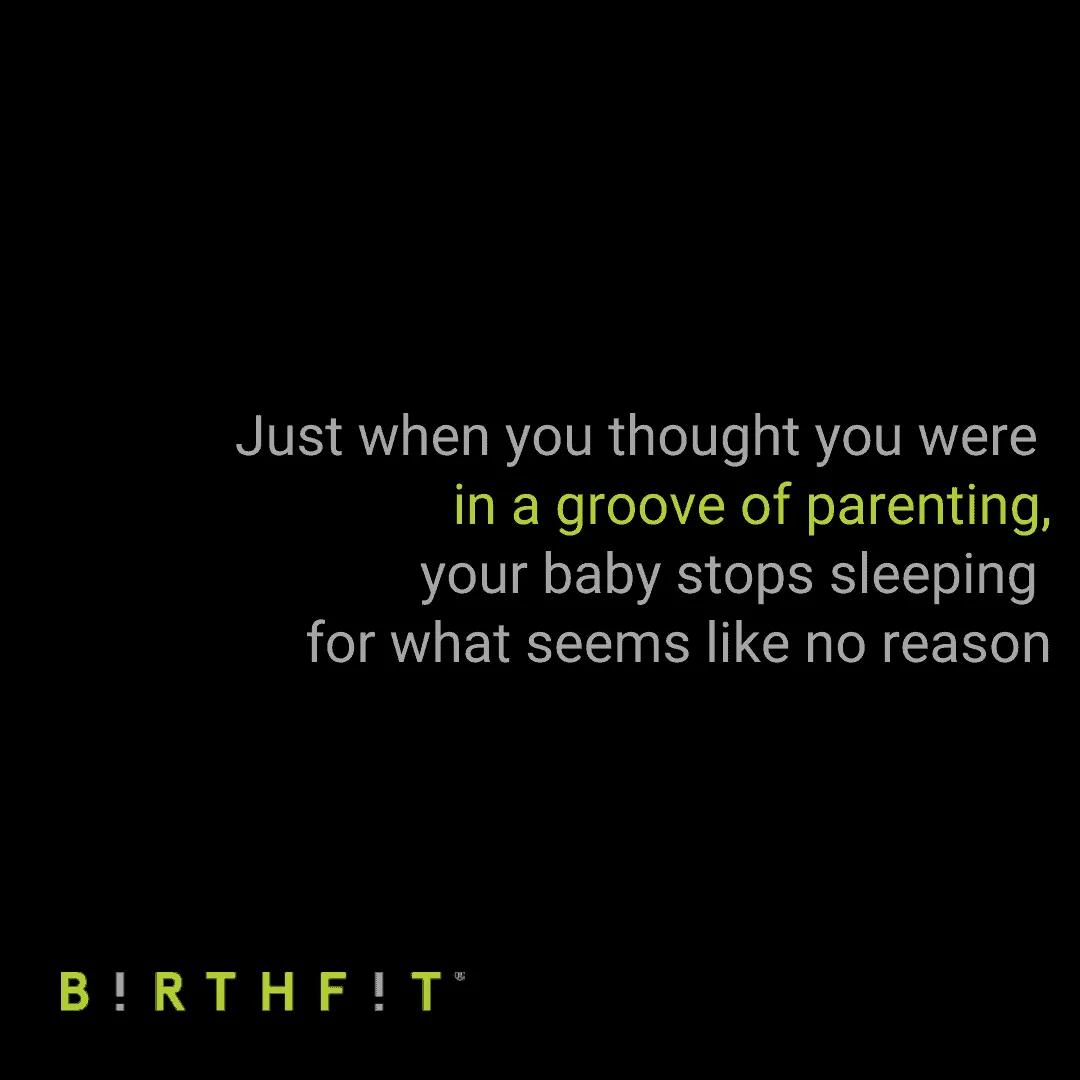Just when you thought you were in a groove of parenting, your baby stops sleeping for what seems like no reason. As you lie awake with them in the middle of the night, you realize they’ve hit the dreaded “four month sleep regression” – now what?
The most important, but most difficult, part about this change in your child’s sleep schedule is that this change is not actually a regression, but a developmental milestone in their brain and sleep development.
Adults sleep in waves and cycles. You have two types of sleep that cycle throughout the night: rapid eye movement sleep – also known as REM sleep – and non-REM. There are three stages of non-REM sleep and they allow for increasingly deeper sleep as you progress from non-REM Stage 1 to non-REM Stage 3. So for simplicity sake, you have sleep cycles that are grouped into REM and non-REM and these alternate every 90-120 minutes (1).
Starting with birth, babies have a somewhat constant and immature state of sleep. Newborns don’t have true REM and non-REM. Their sleep during this time is categorized as “Active”, “Quiet” and “Indeterminate.” Active sleep is similar to an adult in REM sleep and quiet sleep is equivalent to non-REM sleep. Healthy newborns sleep and only wake up in the event of hunger or a wet diaper; they are in a deep sleep most, if not all, of the time and can usually sleep anywhere and with anything going on around them.
At around four months, however, babies start to develop a cycle with their sleep. Similar to an adult, they develop smaller cycles of active or more alert and inactive or non-alert sleep. This is why when we say baby has a “regression” in their sleep around this time, they are actually becoming more aware of their surroundings, causing them to wake up more easily.
Why does this happen?
At about four months, babies begin to become more mobile by rolling over. Rolling over activates a part of the brain called the cerebellum, which coordinates movement and sensation. This is partly why your baby is starting to sense their surrounding and respond by waking up. The problem is that your baby doesn’t know how to go back to sleep, like an adult does.
There are more than just neurological reasons for changes in sleep. Many of the changes with your baby’s growing body just so happen to add to the stress of a changing sleep rhythm. Another reason why this sleep change may happen is due to teething. Erupting teeth take a long time to break through the gums and this process can be painful and disruptive to sleep. This results in fussy bedtimes, less naps, and earlier wake times. Babies also don’t eat as well when they’re teething, so you can add “going to bed on an empty stomach” to the list as well.
What do I do about this?
- Stimulate their brain. By stimulating your baby’s brain, you’re able to wear them out mentally, which helps their mind from being restless during sleep time. Brain stimulation for babies can include any of the following: peek a boo, reading them stories with vibrant colors, dancing, singing and babywearing walks. Another way to help with brain development is making sure your child has been checked by a pediatric chiropractor. Pediatric chiropractors trained under the International Chiropractic Pediatric Association are able to ensure that your child’s brain and nervous system are developing optimally to allow your little one to reach these milestones with ease.
- Implement a nighttime routine. Just like adults, babies do better when on a nightly routine. This helps their brain understand that a pattern will happen before it is time for bed. Some tips to help the routine be the most beneficial include:
- Reducing screen time and dimming the lights. This helps their brains understand that it is night time and time to sleep.
- Promoting a peaceful sleep environment. Because babies are more alert during their alert sleep, any sound or noise will trigger them to wake up. Blackout curtains, soft music or a sound machine may be helpful for helping ensure undisturbed sleep.
- Connect with them physically before bed by snuggling with them, feeding them, and even a little pre-bed infant massage may be helpful for your little one to understand that sleep is near, but so are you.
- Of course, no nighttime routine is complete without a bedtime story or a bedtime prayer.
- Putting baby to bed “drowsy, but not asleep” is also key for helping your child understand that they can soothe themselves gently before falling into a deeper sleep.
- Know that this will pass. It is totally normal that your baby is experiencing this change. This change should only last 2-4 weeks. However, this is the perfect time to ask a friend or family member for help or consider hiring a night nanny.
I know you’re tired and ready for this “ four month sleep regression” to be complete, but take this time to appreciate that your little one is growing, thriving, and that this will be over soon.
If you’re reading this ahead of the four month sleep regression, take this as a your warning of this developmental change. Prepare ahead of time for this change to occur by resting more the weeks leading up to this, getting baby in a good routine, and preparing for help before you’re desperate.
Dr. Whitley Jagnanan, DC, CST, BS
www.vitalhouston.com @vital_houston
References
1. https://www.ninds.nih.gov/Disorders/Patient-Caregiver-Education/Understanding-Sleep
2. https://www.nature.com/articles/srep46104
Get Started
Effective programs for both MIND ⊕ BODY
This is a general strength and conditioning program for women in all seasons and cycles of life. You receive four workouts each week with options for those with limited equipment and variations on movements.
Start moving and training with your cycle ❤︎
Slow is Fast when you heal your core and pelvic floor from the inside out by starting with breath work, natural movement patterns, and continue to progressively build upon a solid foundation. The number one referral for doctors and midwives.
Are you open to conception? Join us in B! Community training. A general strength and conditioning for women that train while honoring their menstrual cycle. Everyone is in a different part of their journey, we support you where you are.
Do Pregnancy Different, when you connect with your body daily through a safe, effective prenatal training program for all levels and all fitness backgrounds that includes core and pelvic floor prehab, mobility, strength, and conditioning.





